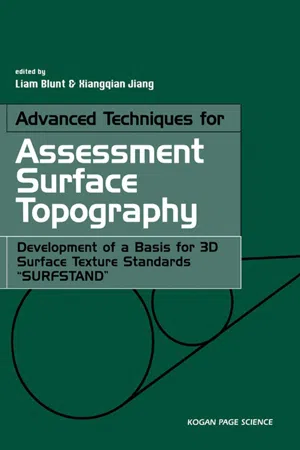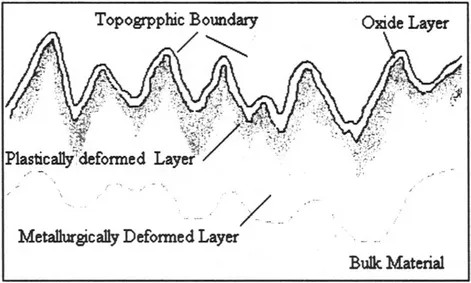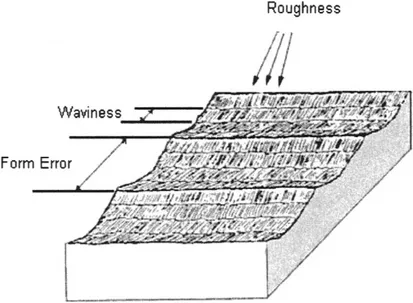1.1 Defining the nature of a surface
An appropriate question at the beginning of a text like this might be “what is a surface?”. The answer to this question is not simple, though considering a surface as a boundary is a good start. Bearing this in mind, the surface of an engineering component can therefore be thought of as the physical boundary between the work piece and the surrounding environment.
The real surface of a workpiece has been defined in international standards (ISO) as:
A set of features which physically exist and separate the entire workpiece from the surrounding medium (ISO 14460-1)[1].
It would be false to assume that the surface of a workpiece is invariably mechanical in nature. In fact the electromagnetic surface of a workpiece is an equally valid concept. The definitions ISO 16610-1, of both are rather cumbersome but are given below.
Real surface of a workpiece (mechanical)
Boundary of the erosion, by a spherical ball of radius r, of the locus of the centre of an ideal tactile sphere, also with radius r, rolled over the real surface of a workpiece.
Real surface of a workpiece (electro-magnetic)
Locus of the effective ideal reflection point of the real surface of a workpiece, by electromagnetic radiation with a specified wavelength.
For most purposes, however, especially where the workpiece interacts with its working environment through some form of mechanical contact it is the mechanical surface that is of interest. This is the surface that is measured using standard surface metrology techniques and it is this surface that is referred to on engineering drawings of components to be manufactured.
A further rhetorical question might be, why are we interested in surfaces? The clear reason is that it has been shown that 90% of all engineering component failures in practice are surface initiated, through mechanisms such as fatigue cracking, stress corrosion cracking, fretting wear, excessive abrasive or adhesive wear, corrosion, erosion etc. Clearly then, it is important to understand the properties of the surface and near surface zones of a component. These properties can be grouped together under the term surface integrity [2].
A glance at the nominal technical drawing of an engineering component clearly shows that the drawing assumes that each surface of the component is perfectly smooth, straight, clean and free from defects. There is an assumption that the manufacturing engineer can achieve this using the techniques at his disposal. This surface, the one assumed by the drawing is called the nominal surface. The manufacturing engineer now studies the drawing and attempts to manufacture the component to the specified dimensions within the tolerance limits. When manufacturing the component the engineer knows that it is impossible to manufacture a perfectly smooth surface, as the particular manufacturing method chosen will leave a micro-scale “fingerprint” on the surface which is unique to that manufacturing process. The nature of that “fingerprint” is referred to as the surface texture or surface topography of the component. Normally, this consists of a series of peaks and valleys that have characteristic shape size and spacing.
As well as affecting the shape of the surface texture the manufacturing method chosen also affects the layers directly below the surface of the component. For example, if we take the machined surface of a metal such as steel and take a cross section through the surface we can see the surface is made up of a number of layers (Figure 1.1).
Figure 1.1 Schematic cross sectional view of a surface showing the surface and sub surface layers
These layers consist of:
• An oxide layer, which all metals possess, this layer being several nanometers thick.
• The topographic layer, the hills and valleys that make up the shape of the surface. These result from the material removal (or addition) process and are produced by the unit manufacturing process (tool passage, electrical discharge, plating process etc.).
• A plastically deformed layer produced by the machining operation.
• A metallurgically deformed layer resulting primarily from heating during machining.
• The bulk material.
Figure 1.2 shows an example of a cross section through (a) an abusively ground steel surface, and (b) a gently ground steel surface. What is clear from the image is the distinct layering of the surface zone and also how the severity of the grinding operation has affected the surface layers and the surface roughness.
Figure 1.2 Ground surface cross section a) abusively ground b) gently ground
Whilst the sub surface layers are critically important, they are very difficult to measure without destroying the component. Therefore engineers have concentrated on measuring the surface roughness as both a means of quality assurance and as a means of inferring functional performance. The geometrical form of any surface is usually referred to as the surface texture. Conventionally the texture is made up of features defined as roughness, waviness and form (Figure 1.3). Traditionally, when the surface texture is quantitatively measured it is only the roughness that is analysed and the waviness and form elements are mechanically, electrically or digitally filtered out from the recorded data.
Figure 1.3 Roughness, waviness and form of an engineering surface [3]
The difference between the roughness, waviness and form characteristics of the surface texture is based on the surface wavelength or peak to peak spacing. The great problem with these conventional definitions is that the point at which roughness becomes waviness (cut off) is arbitrary and is usually related to the manufacturing process from which the surface derived or from the intended function of the workpiece. For example, what would be considered as roughness on an automobile axle would be considered waviness of form error on a watch spindle [3].
As a rule roughness can be considered as being produced by the method of manufacture rather than the machine, and constitutes tool or grit marks and is usually of a periodic nature. On a finer scale there is tearing of material, as a result of built up edge formation and tool tip irregularities. Waviness is usually attributed to an individual machine, for example an unbalanced grinding wheel, tool feed irregularities and general chatter vibrations. Form errors are usually caused by a lack of rigidity of the workpiece during the machining operation allowing it to flex or bend. Slide way undulation can also cause form error. Strains in the material, surface induced trough heating or excessive surface residual stress can cause flexure and form error. Usually, form errors produce only one or two undulations over the dimensions of the assessed surface.



